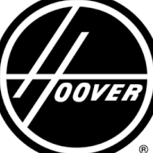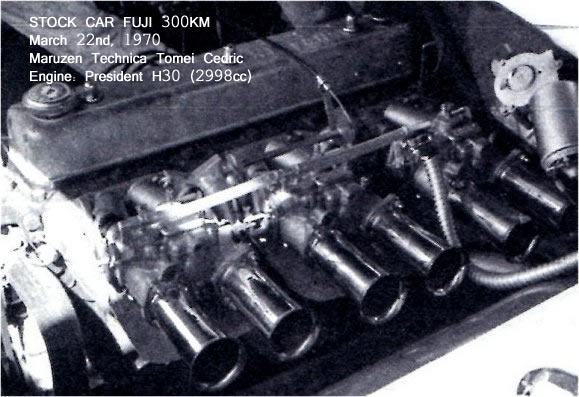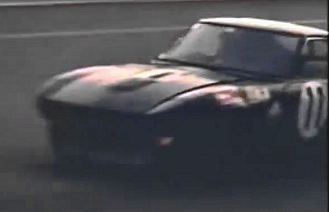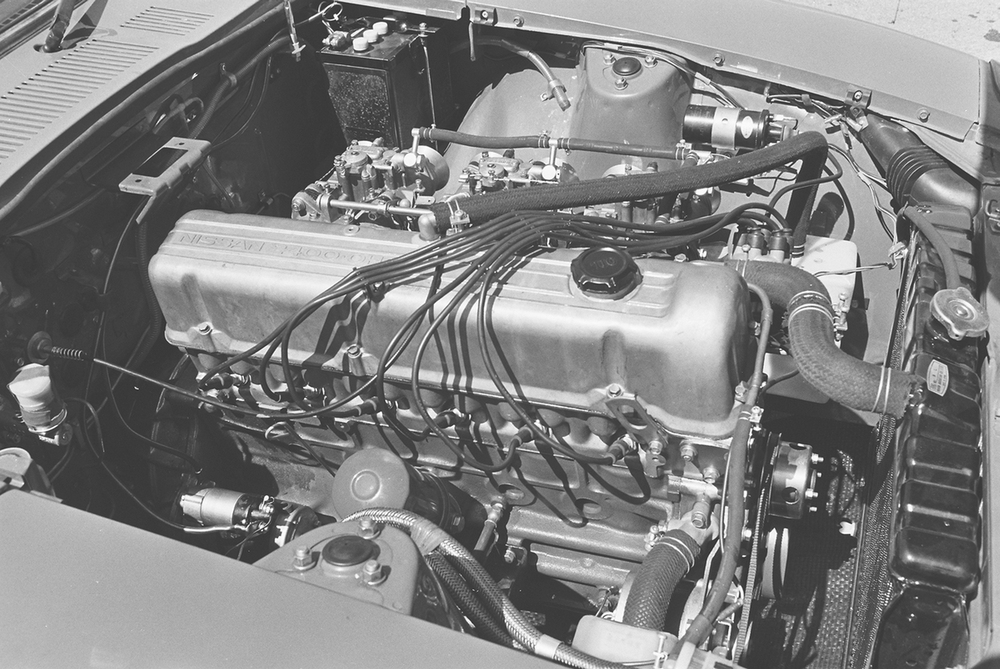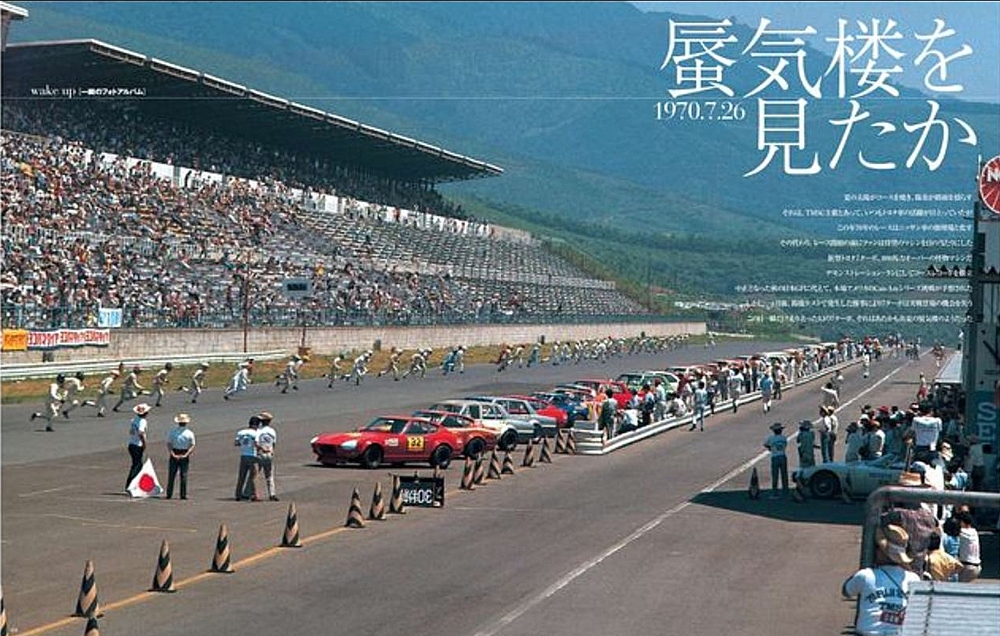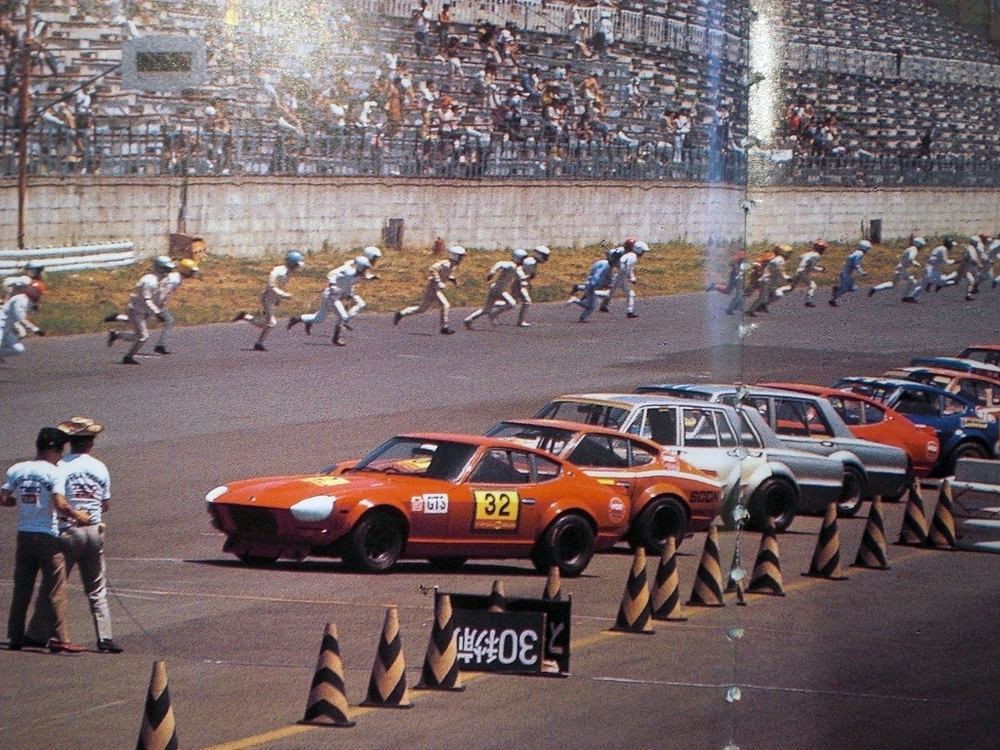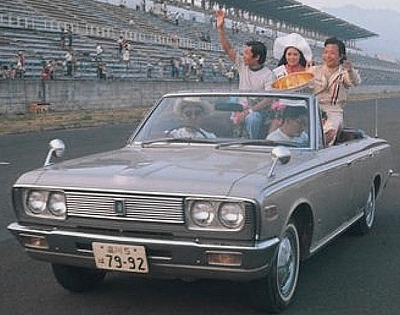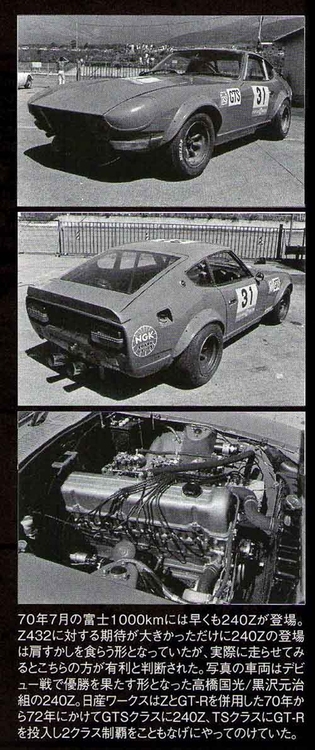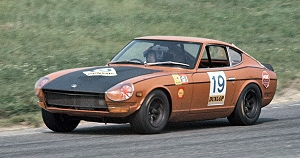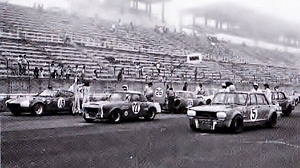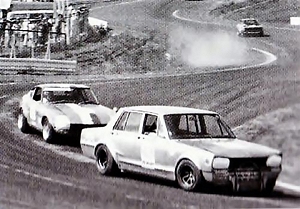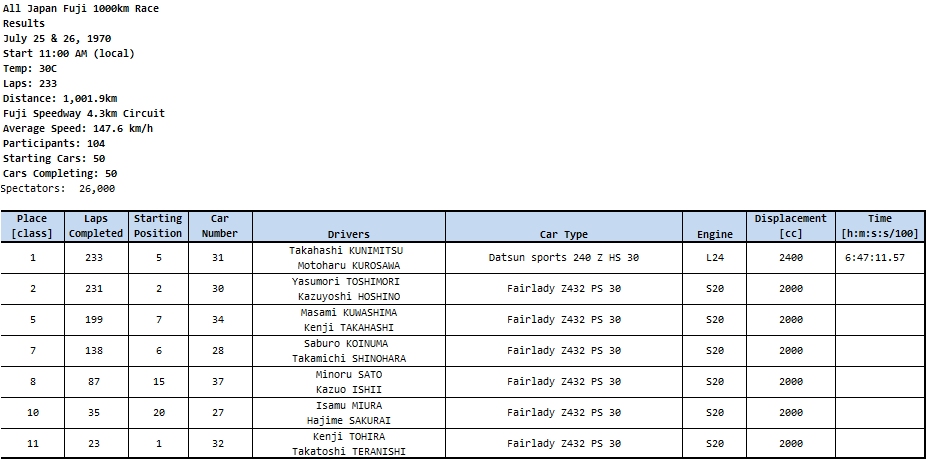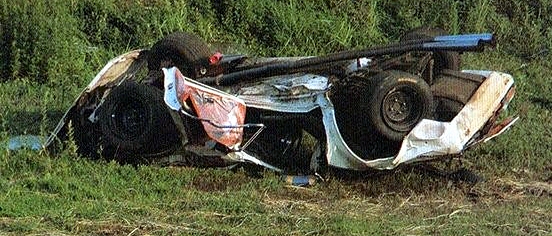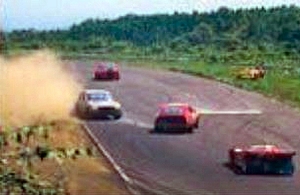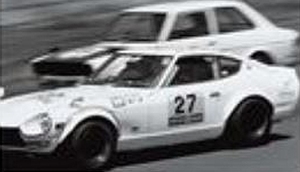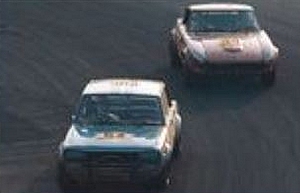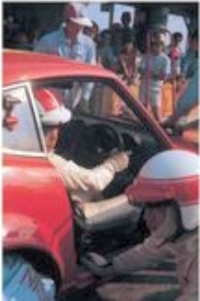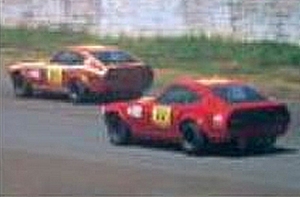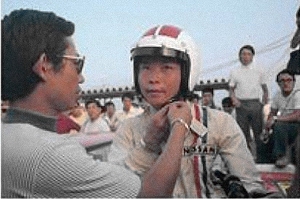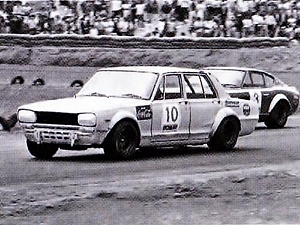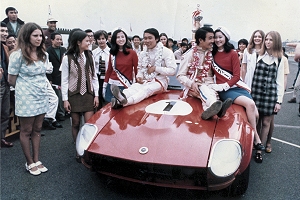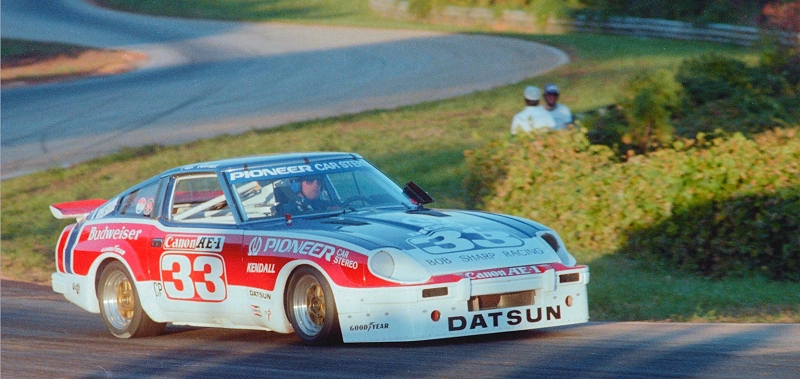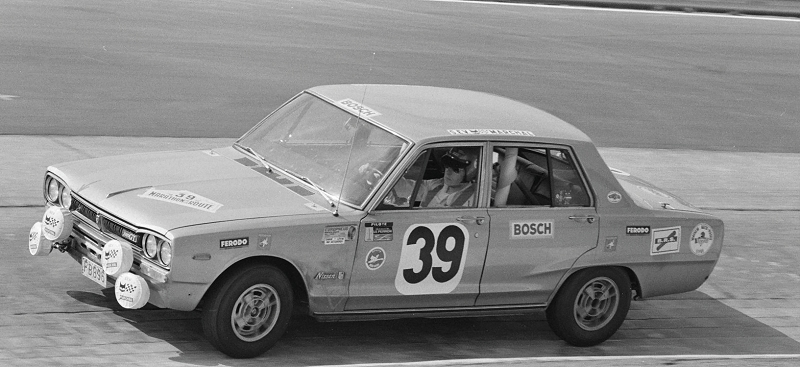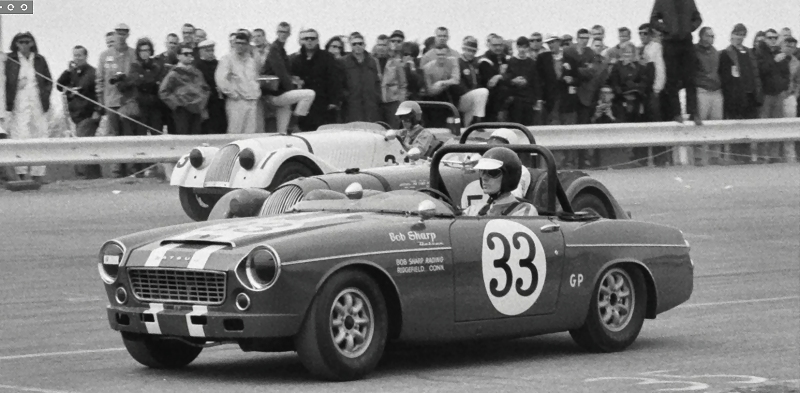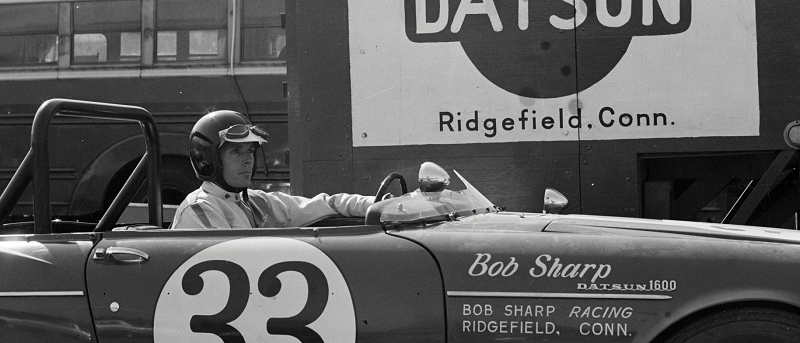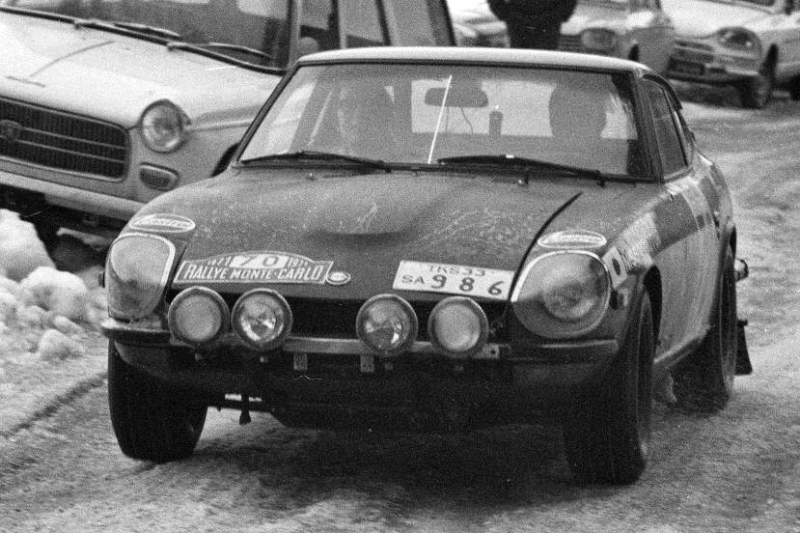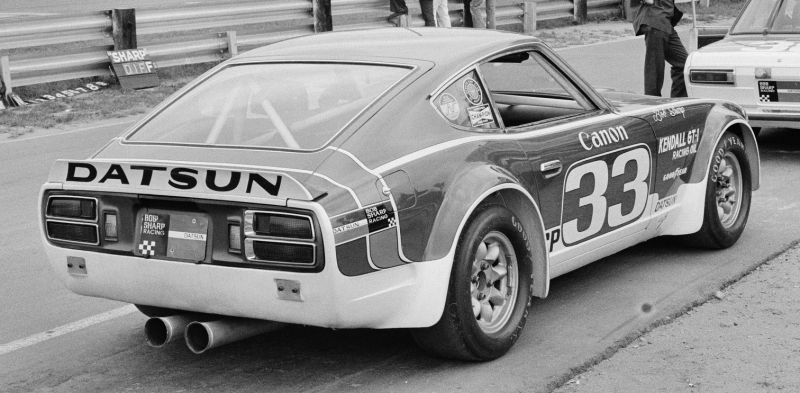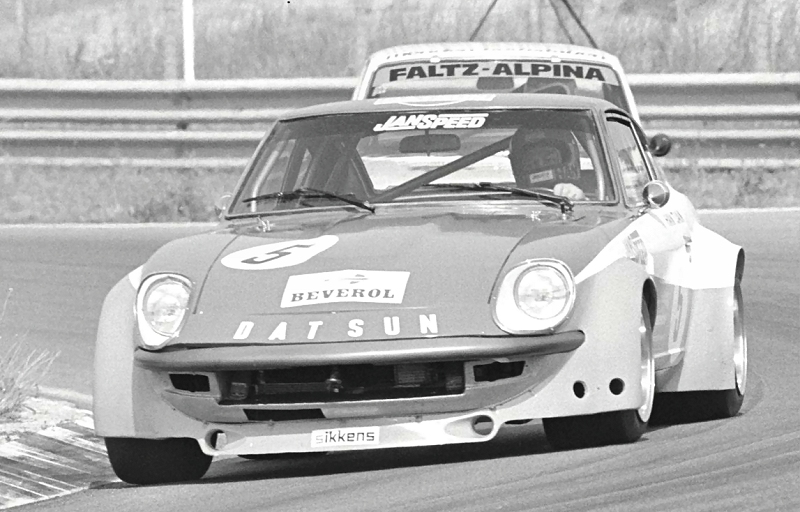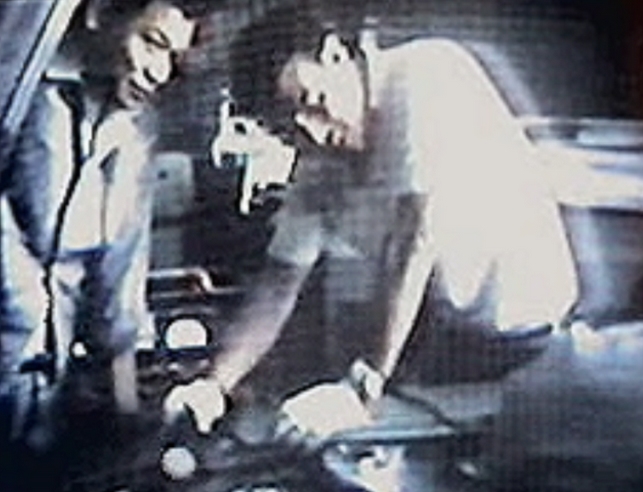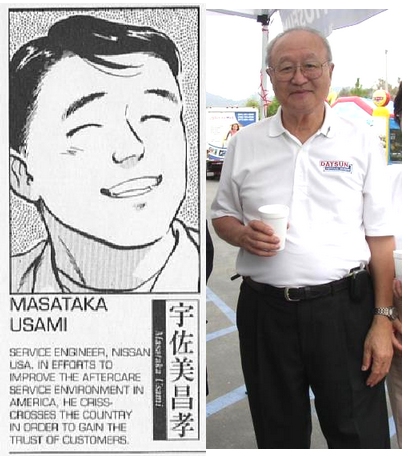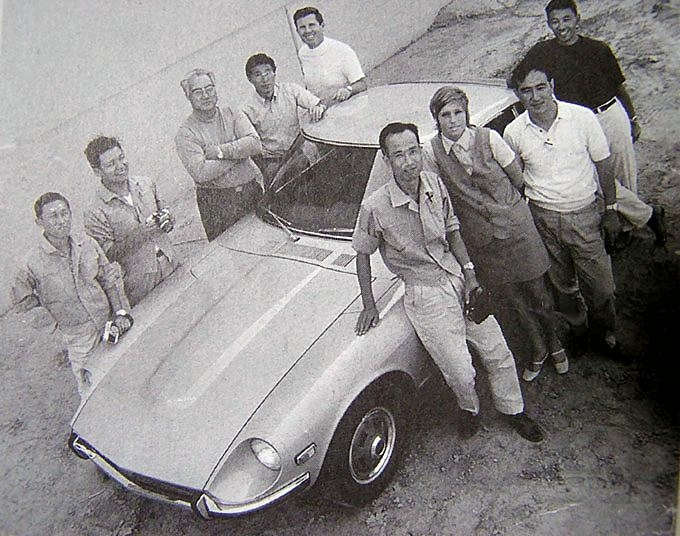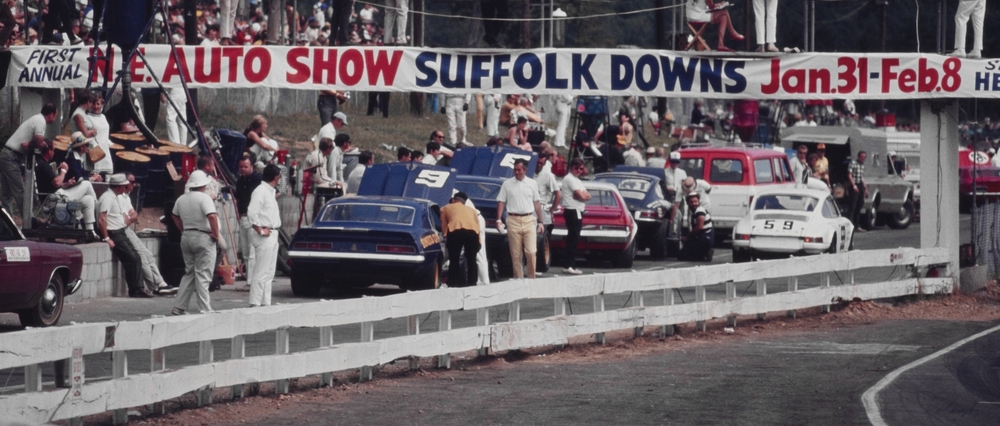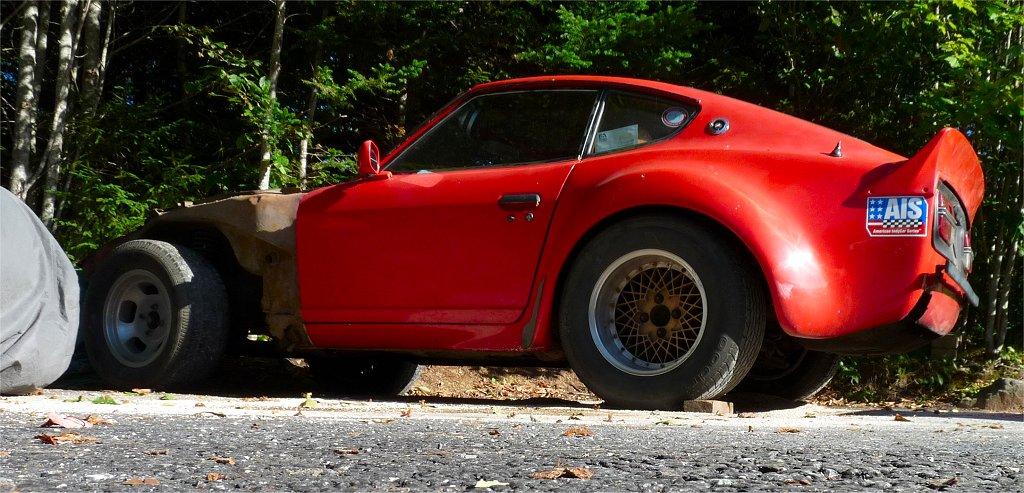
Everything posted by 240260280
-
L24 Battles Six S20's. Guess who wins?
Thanks Alan. I corrected it. Your input to help correct is appreciated. I had to compare the photo in the victory lap car to other ones to ID correctly. I made an error.
-
L24 Battles Six S20's. Guess who wins?
Mystery solved on the rad hose. It is a 432 radiator and the top inlet is just right of centre. A HS-30 240z's inlet is well left of centre.
-
The Displacement Bug Hits Japan: First 3 litre Z was in 1971
Driver: Masami KUWASHIMA Name: "Fairlady Z Black Special" Type: Datsun Sports 240Z Chassis: Nissan HS 30 Engine: Nissan H 30 (3 litre Inline 6 from President) Displacement: 3.0 litre It raced at Suzuka Great 20 Drivers' Race August 12, 1971 with triple Webers. Car #11 Here is the same engine in a Cedric much earlier. Learn something new every day!
-
Nissan Factory restoration cars
Count me in! You could publish a few books with your knowledge! Do it!!!
-
L24 Battles Six S20's. Guess who wins?
The winning L24 and engine compartment seems pretty basic from the outside. A few items to note: throttle linkage replaced by cable dead-headed fuel piping architecture oil cooler and fittings deleted mechanical fuel pump alternate PCV system with large white plastic catch can deleted fan non-stock damper pulley remote oil pressure measurement sensor fibreglass belly pan hood latch delete (racing pin arrangement) stock battery, alternator, distributor, radiator, coil, starter very light coloured distributor cap. Plugs seem stock. stock wiring harness unknown hose from battery area to drain on left tower/wheel well. It seems to go behind battery then across the fire wall to the transmission tunnel area. heater hose delete shortened/modified fuel rail stock-ish fuel filter Stock hood prop, vent elbows, rad over-flow drain hose, v-reg cover Washer fluid hoses in place along with stock wipers brake booster not in shot. Master brake cylinder and clutch master cylinder seems to be stock no camber mods to shock towers engine lift bracket in place
-
L24 Battles Six S20's. Guess who wins?
By July of 1970, the Nissan Factory Team had entered the 432R in four significant* endurance races. They did very well at quickly reaching number one place in a short period of time: January All Japan Suzuka 300Km (dnf) [it snowed too] March All Japan Stock Car Fuji 300Km (2nd) April Race de Nippon Fuji 6hrs (1st) May All Japan Suzuka 1000km (1st) 1970 All Japan Suzuka 300km (Jan 18, 1970) Car #68 Fairlady Z432R Moto KITANO (dnf) 1970 All Japan Stock Car (March 21/22, 1970) Fuji 300Km Car #20 Fairlady Z432 24 laps Time 39: 36.16 Moto KITANO (2nd) Car #16 Fairlady Z432 24 laps Time 39: 36.43 Masahiro HASEMI (3rd) 1970 Race de Nippon (April 12, 1970) 959km Car #1 Fairlady Z432R 159 laps Moto KITANO / Masahiro HASEMI (1st) 1970 All Japan Suzuka 1000km (May 23/24, 1970) Car #19 Fairlady Z432R 167 laps Hiromi NISHINO / KOJI FUJITA (1st) The next significant race was on July 25 and 26th. It was the All Japan Fuji 1000km Race. 104 teams battled for the 50 slots available for the final 1000km event on July 26th. By this time the Nissan works team had several 432R's configured and other teams had access to the 432R. A total of seven 432R's qualified for the final in the GTS-2 category. This race was particularly interesting as the GTS-2 rules enabled engine displacements up to 2.5 litres. The Nissan Oppama Factory Team availed of this. In one of the 432R chassis, they replaced the S20 DOHC 2.0 litre engine with a 240z's L24 SOHC 2.4 litre. The S20's were further embellished with mechanical fuel injection where as the L24 had triple Mikuni carbs. Due to the fact that all the bodies were the same lightened spec of the 432R, this race became an apples-to-apples engine comparison where a more sophisticated and complex, but smaller displacement, 4 valve, DOHC S20 was pitted against a relatively simple 2 valve SOHC L24 with more displacement.... but it was six against one. As they say in the USA: "K.I.S.S. Keep It Simple Stupid." and "There ain't no replacement for displacement.". Above is the L24 with Triple Mikunis that challenged Six S20's in the very early days of S30 racing. The 1000km race took place during a heat wave with air temperature at 30C (look at the crowd sheltering from the sun in the upper grand stands in the photo above). The race ended after the first car completed the required 1,000km (233 laps). The seven 432R's starting places were: Car #32 Pole Position (Kenji TOHIRA & Takatoshi TERANISHI) Car #30 2nd (Yasumori TOSHIMORI & Kazuyoshi HOSHINO) Car #31 5th (with L24 engine) (Takahashi KUNIMITSU & Motoharu KUROSAWA) Car #28 6th (Saburo KOINUMA & Takamichi SHINOHARA) Car #34 7th (Masami KUWASHIMA & Kenji TAKAHASHI) Car #37 15th (Minoru SATO & Kazuo ISHII) Car #27 20th (Isamu MIURA &) The race had the classic "Le Mans" running start. During the race, a GT-R in the TS class challenged the L24 432-R There were also crashes. Car #27 crashed on lap 35. Several spins: Lots of exciting passing And problems with lug nuts: While in the lead at 5 hours into the race, Car #31 had to repair a broken lug nut that was discovered on a scheduled pit stop. This allowed the GT-R Car #54 in TS3 Class, piloted by the great driver, Masahiro HASEMI, to grab the lead. On Lap 225, the L24 powered 432-R reeled in the GT-R and passed it. After 233 laps of the 4.3km course, the 432R with L24, Car #31, got the checkered flag. It won the race and it won the class. More interestingly, Takahashi KUNIMITSU and Motoharu KUROSAWA in their "Datsun Sports 240 Z HS 30" easily took on, and defeated, six similarly prepared 432R's with S20 engines. Car #31 432R with L24 Engine Wins the All Japan Fuji 1000km Race. Motoharu KUROSAWA(l) and Takahashi KUNIMITSU (r) The L24 in an effectively "lightened 240z chassis"**" finished two laps ahead of the nearest S20 432R competitor. The rest of the S20 432R's finished 34, 95, 146, 198, 210 laps down. The L24 had no competition. It was strong, reliable, and a race worthy engine that proved itself on its first outing in Japan. As an epilogue to the race, there was great disappointment for the S20 engine. The All Japan Fuji 1000 km results were the writing on the wall for the relatively new S20 power plant. Going forward, it was generally not favoured by racers in classes where the L24 could be used. In fact, the following year's 1971 Race de Nippon 6hr was won by a Factory 240z L24 piloted by Takahashi KUNIMITSU & Masahiro HASEMI. If you recall from the top of this post, this is the same race where, in April of 1970, the S20 432 alos piloted by Moto KITANO & Masahiro HASEMI captured its first win. The reign of the S20 was short indeed. Masahiro HASEMI, the former great racer and team owner (who was the first to place first in the 432-R and who placed 11th with the fastest lap in the famous wet 1975 Japanese Grand Prix race at Fuji (Lauda withdraws, Hunt gets 3rd) ) states: that in having raced the Factory 432R's fitted with both S20 and L24 (as a Factory team driver for Nissan), it is the L24's mid-range torque that gives it the advantage when battling S20's. When going off the racing line, torque matters. With the experience as a team owner, he comments that the L24's simple design is easier to tune and to maintain for racing duties compared to the more complex S20. This is why privateers in Japan welcomed it with open arms following its first showing and first win at the 1970 All Japan Fuji 1000 km. HASEMI also comments that he favoured the Skyline GT-R over the 432R. He found the 432R to be too flexible for circuit racing. Note: HASEMI piloted the GT-R in this race that placed second. This placed him first in his TS3 class. A few interesting food-for-thought take-aways: The Japanese Automotive Federation, rigorous in its ways, records the winning chassis to be a "Datsun Sports 240z HS-30" (RHD version of the same chassis shipped to the USA) where as the other 6 Z's are stated to be Fairlady Z432 PS30. So, was the winning Chassis really a 432R with an L24 popped in? Also, was the 432 JAF record missing the "R"? The heavier 240z body exported to the USA was further race-strengthened there through stitch-welding, panel reinforcements, and bracing yet it still continued to win championships for a decade with the additional weight; therefore, was the designed weight savings of the 432R chassis variant along with the accompanying rigidity challenges, lost in the mix? Is it possible the 432R body was designed for, or was just a better fit for rallying purposes rather than track? Notice the evolution to chin spoilers between May and July. I wonder what parallel evolution was going on in the USA? Should the winning L24 & Chassis be renamed from 432R to 231R? S20 engine seems to excel at high rpm, high speed, open track qualifying as per HASEMI's comment that it works well on the racing line and by its favourable qualifying times. * Other races include: Photo TBD. Jun 6/7 All Japan Fuji 300 Mile Race Tournament Masami KUWASHIMA Car #4 Fairlady Z432 25 laps Time 56: 53.98 (1st) Jul.5 6/7 Hokkaido Speedway Yasumori SHINOMORI Car #3 Fairlady Z432-R (PS30SB) 57 laps Time 1:09'51"09 (3rd) Jun 28 All-Japan Driver Championship Round 4 Tsukuba Tournament Masami KUWASHIMA Car #66 Fairlady Z432 50 laps Time 59: 23.56 (2nd) ** 432R chassis was of nearly same dimensions as 240z HS/HLS30 chassis but with thinner sheet metal in places and thicker gauge steel in areas and components requiring it. There were some replacements of parts such as the hood and some glass with lighter materials. It sat ~ 5mm higher than a typical 240z.
-
HLS30-00006 at the Crusher?
Many thanks! That is greatly appreciated!
-
production number for 1969
I actually like the fuel filler on the driver's side. More convenient and easy to see out of rear view mirror on an unfamiliar rental when you pop it approaching a service station. Back in the 60's I do not think there were many self-serve stations in existence so the point is moot in Japan and the USA. Iterations of the Z prototypes and clay model leading up to the final have the exhaust on left, right, and both. It seems to be logical that in the end, the L engine dictated the side of the car which the exhaust pipe would run. It also makes it easier to fit the muffler on one side and the fuel filler pipe on the other. By late 60's there may have been regulations regarding this as well or it was just good practice (but smoking in the back seat of a 510 with your back against a fuel tank seems to point to no rules about fuel storage near points of ignition). Most Nissan cars leading up to the Z have the exhaust on the left and filler on the right but there are exceptions.
-
Let's show vintage racing pictures. I'll start.
-
Let's show vintage racing pictures. I'll start.
-
Let's show vintage racing pictures. I'll start.
-
Let's show vintage racing pictures. I'll start.
-
Let's show vintage racing pictures. I'll start.
-
Let's show vintage racing pictures. I'll start.
-
Let's show vintage racing pictures. I'll start.
-
Let's show vintage racing pictures. I'll start.
-
production number for 1969
Of course not for Mr. K. to single handily do this. He was a great leader and catalyst but he needed the opportunities, timing, a great team, a dynamic company and a lot of luck too. I agree on the blanket blurb... seemed daft to me too. It is interesting how different regions deal with things. When I was living in Ireland, I would often see people pouring pans of hot water on their wind screens to de-ice. It worked quickly. Here in eastern Canada, we scrape the ice and often flick the wipers up before parking at night.... or some have remote starters and turn their vehicles on to warm up while inside the house 5min before driving away. I believe now there are even newer chemical products that you can put on your windows to reduce ice adherence. I think even a piece of plastic or cardboard over it can trap enough heat and block the moisture to make clearing easier. In Quebec where there is a lot more snow and colder winters, people commonly erect car tents in their driveways to mitigate the snow on the car. In Central and Northern Canada (and throughout when owning a heat-cycle diesel), many use block heaters and plug their car in at night. Every region seems to have their own tricks. I am sure those in Hokkaido and in Canada have converged in their techniques by now.
-
FILMS "Road test in the U.S. & CANADA Oct-Dec 1969"
Hi Kats, Could that be Mr. Masataka Usami standing to the right of the model in the photo above? Also would he be the expert tuner in this still from your videos? (with Mr. Hitoshi Uemura on the left)
-
production number for 1969
Many may find this excerpt interesting. It demonstrates how Nissan had to adapt Datsun products to North America well before the Z sports car was designed specifically for the North American market. (To replace their only sports car (roadster) in its biggest market) : Source: http://datsunforum.com/datsun-discovered-america-part-3/ Masataka Usami, a Nissan executive who lived in Greenwood Lake, New Jersey, and whose own car would not start in cold weather, reported back to Tokyo that Nissan could not have a car that started only two out of ten times. Tokyo was not very helpful. The alleged starting problems were impossible, the home office insisted, since it had checked Hokkaido – Japan’s northernmost island, where Datsuns started without difficulty – was just as cold as New Jersey. Usami replied that in Hokkaido those few Japanese who were privileged to own cars lovingly put blankets over the hoods every night. Tokyo asked why Americans didn’t do the same thing. Usami explained that to the Japanese a car was a privilege, but to Americans it was an appliance, and they expected it to work without pampering. I had the same experience first hand when I worked nearly 5 years for a Chinese company who designed and produced international products that were not selling here in North America. No one in head office listened to anyone in North America whether they were local or transferred from HQ. It ultimately caused so many missteps that the company had to pull out of this market. Nissan obviously did not do this and adapted their products to the North American market; otherwise they would have failed like the company I worked for. In the early to mid-sixties, it is because of Mr. K's perseverance, automotive knowledge, powers of observation, intuitiveness, logic, understanding of people, understanding of customer needs, and international corporate skills that he was able to align Nissan HQ with the North American market. The products followed suit and sold well. For being accused of turning up "late to the discussion": It is in the spirit of accuracy and adding new and useful content that I am contributing to old posts. This is very important for the organization of content on forums for the benefit of others who come across these threads in the future. The thread should be complete with the information contained within it, not scattered throughout the forum. People are not visiting this forum to look at time stamps. I have done this (updated old internet posts) on the technical side of Z's for nearly 14 years. My interests have changed slightly as I am now delving into the history and design of the Z; however, I am doing the same as I always did with respect to posting information helpful to others. With so much great historical and design data on this forum over the years from you, Carl, Kats, Chris, Mike and many others, it is difficult to find new and interesting content to add (as most has been put forth);however, even though I am "late to the game", I am fortunate to contribute some new data in this area that I hope others can enjoy. I think you may have enjoyed this example: http://www.classiczcars.com/topic/33633-24th-october-1969-the-s30-series-z-public-debut/?page=2#comment-509152
-
Philosophical discusion on build dates
I think it is/(maybe was) a California thing where the number on the licence is unique to each dealer and many cars on the road with the same plate number is manageable.
-
production number for 1969
-
Philosophical discusion on build dates
Kats, You may be correct in seeing 3 different numbers. My guess is that the test team could legally driver around the USA in '69 with the DLR 2177 California dealer plates but in order to drive the car across the border into Canada, they needed a more permanent plate thus the requirement to formally register and licence the vehicle in California. The two cars probably have different plate numbers in the Canadian pictures.
-
HLS30-00006 at the Crusher?
but... this photo (that seems to be summer of 1969 based on cars... please double check my observation) would put the Boston Auto Show the first week of February 1970.
-
Feb 1971 Amsterdam Auto Show 240z
Note: - car manufactured pre-Feb 1971 - no bumperettes on rear bumper - bridgestone tires - full rubber strip around rear bumper - hatch vent - no rear marker lights - air valve aligns with spoke on hub cap
-
HLS30-00006 at the Crusher?
The plot thickens... I guess that may explain the over-rider bar appearance in NYC too. The Boston Auto Show window seemed to jump around a bit (~ March 1910 and January Now) but it is clearly Nov in 1971 when the first Lamborghini Miura SV was shown.... so we can assume the 1969 HLS30-00006 photo is from November.




